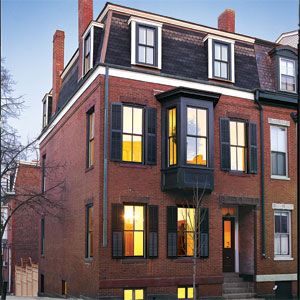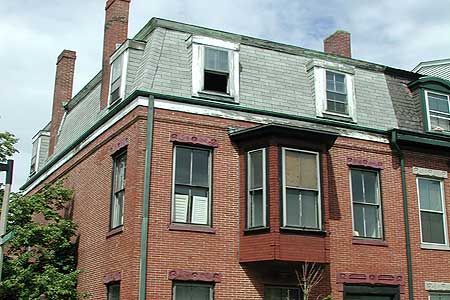
Early on in the project, architectural conservator Andrea Gilmore, who
usually advises This Old House on historic paint schemes, dropped
by the Charlestown house to assess the state of the building’s
brownstone lintels and sills. She told us that they were originally
unpainted, and the wood of the bay window was covered in a brown sand
paint meant to imitate brownstone, the effect being one of a unified
masonry building of brick and brownstone.
Climbing and probing, what Andrea uncovered is not particularly
encouraging. Brownstone, a soft sandstone, is prone to erosion and,
since it is a sedimentary rock laid down in horizontal layers, splitting
along its “bedding” lines. Our beautifully carved lintels were worked
parallel to these layers and put up on the building with the bedding
lines vertical, just the ticket for water to enter, freeze, thaw and
split them apart. Past attempts to patch them with some kind of
concrete, and the application of paint, have done little to prevent
their further decay. A few are in good shape, either because they are
out of the rain, like the one beneath the bay window, or perhaps because
their stone is denser. But the rest need help—or, more precisely,
replacing. Not only are they losing their beauty, but the possibility
of pieces spalling off and falling to the sidewalk presents a real
hazard to passersby.
Andrea suggested two possible solutions, each predicated on removing the
decaying lintels. One: Call the Connecticut quarry that still produces
brownstone, get some and find someone to carve them to match the
existing. Expensive. Two: Choose the best of the existing lintels and
make a latex mold of it, fill mold with cementatious mix, repeat, and
paint resulting cast stone lintels to look like brownstone. Less
expensive, but not cheap by any means.
The Charlestown homeowners considered replacing the damaged brownstone, but that
would involve using available or quarried stone that might or might not
match the rest of the house and would require expensive carving.
Pre-cast concrete offered a faster way to repair their home without
breaking the bank. For the decorative and structural brownstone pieces,
we used a rubber relief to create a mold of the damaged brownstone.
Once we have a good mold, we work to accurately match the stone’s
color. Then it’s time to cast the piece, achieving a good match with
the original. The final product looks great, and helps restore an old
house to its original splendor.

